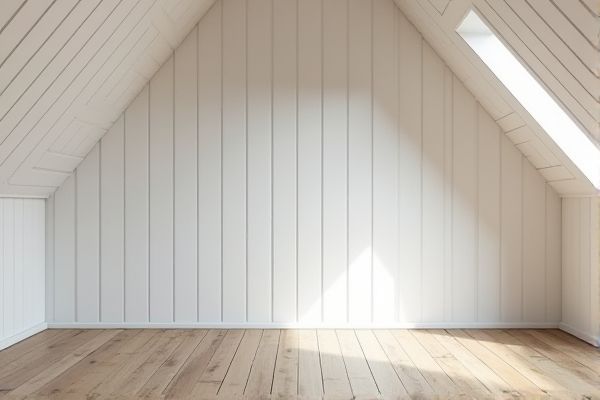
Attic shiplap walls offer a smooth, modern look with tightly fitted horizontal planks that provide excellent insulation and a clean aesthetic, while beadboard walls feature narrow vertical panels with a distinctive tongue-and-groove pattern adding classic charm and texture. Explore the rest of the article to discover which wall option best suits your attic renovation needs.
Table of Comparison
| Feature | Attic Shiplap Wall | Beadboard Wall |
|---|---|---|
| Material | Wood or MDF with rabbeted edges | Wood or MDF with narrow vertical planks and grooves |
| Appearance | Flat, horizontal overlapping boards with clean lines | Vertical planks with distinct bead grooves |
| Installation | Horizontal alignment with overlapping edges for tight fit | Vertical placement with tongue and groove or shiplap joints |
| Durability | Strong, resistant to warping due to overlapping design | Moderate, depends on wood quality and finish |
| Common Use | Rustic or modern farmhouse interiors and attics | Traditional, cottage-style walls, wainscoting |
| Cost | Moderate to high depending on wood type | Generally affordable and widely available |
| Maintenance | Easy to clean; repainting may be required over time | May require regular cleaning and repainting due to grooves |
Introduction to Attic Wall Treatments
Attic wall treatments such as shiplap and beadboard significantly enhance both the aesthetic and insulation properties of your attic space. Shiplap walls provide clean, horizontal lines creating a modern rustic appeal, while beadboard offers a classic, textured look with vertical grooves that add character and depth. Choosing between shiplap and beadboard depends on your desired style and the level of durability needed for your attic environment.
What Is Shiplap?
Shiplap is a type of wooden board commonly used in interior design for creating a smooth, elegant wall surface with distinctive horizontal lines created by overlapping edges. Unlike beadboard, which features vertical grooves and a more textured, traditional appearance, shiplap offers a sleek, modern farmhouse aesthetic ideal for attics and living spaces. Your choice between shiplap and beadboard should depend on the desired style, durability, and regional climate considerations.
What Is Beadboard?
Beadboard consists of narrow, vertical wood panels featuring distinctive grooves, known as beads, which create a textured, classic appearance ideal for attic walls. Unlike shiplap, which has horizontal overlapping boards, beadboard's design adds depth and visual interest while also providing durability and resistance to warping in attic environments. This traditional wall treatment enhances attic spaces by combining aesthetic charm with practical benefits like easy installation and moisture resistance.
Aesthetic Differences: Shiplap vs Beadboard
Shiplap walls feature wide, flat boards with distinctive grooves that create a clean, modern farmhouse look, while beadboard walls consist of narrow, vertical planks with evenly spaced ridges offering a classic, cottage-style charm. Your attic can feel more spacious and streamlined with shiplap's horizontal lines, whereas beadboard adds texture and cozy warmth through its traditional paneling. Both materials enhance visual interest, but shiplap emphasizes simplicity and sleekness compared to beadboard's intricate detailing.
Installation Process Comparison
Installing attic shiplap walls involves aligning tongue-and-groove boards horizontally for a seamless fit, which requires precise measurement and secure nailing to wall studs. Beadboard walls require panel installation or individual beadboard planks, often vertically or horizontally, with an emphasis on fitting grooves tightly and using finishing nails, followed by caulking to seal joints. Shiplap generally offers a quicker installation due to pre-milled grooves, while beadboard demands more attention to detail in aligning beads and seams.
Durability and Maintenance
Attic shiplap walls offer superior durability due to their thick, overlapping boards that resist warping and provide better structural support compared to beadboard walls. Beadboard walls, made from thinner panels with distinctive grooves, require more frequent maintenance to prevent moisture damage and cracking. Your best choice depends on the attic's exposure to humidity and how much upkeep you're willing to perform.
Cost Analysis: Shiplap vs Beadboard
Shiplap walls typically cost more than beadboard due to the thicker, wider planks and intricate installation process, averaging $6 to $11 per square foot compared to beadboard's $3 to $7 per square foot. Beadboard is generally more budget-friendly, offering a classic, textured look with easier and quicker installation that reduces labor costs. Considering your attic renovation, choosing beadboard can lower expenses without sacrificing style, while shiplap adds a premium, rustic aesthetic at a higher price point.
Insulation and Energy Efficiency
Attic shiplap walls provide better insulation due to their overlapping boards that create tighter seams, reducing air leakage compared to beadboard walls, which have narrower grooves that may allow more drafts. Shiplap's thicker planks offer improved thermal resistance, enhancing energy efficiency by maintaining consistent indoor temperatures. Beadboard walls, while decorative, often require additional insulation layers to match the energy-saving performance naturally offered by shiplap installations.
Best Uses: When to Choose Shiplap or Beadboard
Shiplap walls excel in attic spaces where a rustic, wide plank look with tight, horizontal seams is desired, often enhancing farmhouse or coastal interior designs. Beadboard walls are ideal for attics requiring a traditional, textured appearance with vertical grooves, offering added durability and charm in cottage-style or classic settings. Choosing shiplap provides a sleek, modern aesthetic, while beadboard is best for areas needing intricate detailing and a more formal, vintage feel.
Conclusion: Selecting the Right Wall Treatment for Your Attic
Choosing between attic shiplap wall and beadboard wall depends on your desired aesthetic and functional needs; shiplap offers a sleek, modern look with tight, horizontal lines ideal for contemporary spaces, while beadboard provides a classic, textured finish perfect for cottage-style or traditional decor. Both wall treatments enhance insulation and durability in attic spaces, but shiplap typically requires less maintenance due to its flat surface. Consider the overall style of your home and maintenance preferences when deciding the perfect wall treatment for your attic renovation.
 homyna.com
homyna.com